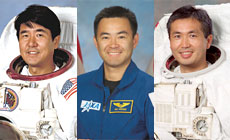


Japanese Experimental Module Kibo

(From left) Astronauts Takao Doi, Akihiko Hoshide and Koichi Wakata
Q. What are the principal missions planned for 2008?
There are two key objectives to be completed by the end of fiscal year 2008. First, we have two satellites launches scheduled by H-IIA Launch Vehicle: the Wideband InterNetworking engineering test and Demonstration Satellite KIZUNA, and the Greenhouse Gases Observing SATellite GOSAT. KIZUNA is a communications satellite developed to provide a broad region with high-speed Internet service. It is expected to be of great assistance in disaster management, education, and telemedicine. And GOSAT monitors the emission, absorption and concentration of greenhouse gases, which cause global warming, in different regions on the globe.
The second key objective is the assembly and operation of the Japanese experimental module (JEM) Kibo. Kibo is Japan's first manned space facility, and it will be installed on the International Space Station on three successive space shuttle missions. Japanese astronauts will be onboard each of these flights: Takao Doi on the first flight, Akihiko Hoshide on the second, and Koichi Wakata on the third. Astronaut Wakata will stay in space for about three months, which will make him the first Japanese to attempt a long-term space stay. I would say that the Kibo mission will be the highlight of 2008.

Kibo Pressurized Module
First of all, I'd like to test Kibo's performance in space, as it is the first Japanese-built human space facility. Once we succeed in validating Kibo's performance, Japan will gain recognition for its ability to manufacture and operate human space facilities. Next, experiments that make use of the space environment will be carried out on board. The research themes for the first term, 2008 to 2010, have already been selected from a public call for applications. We are currently in the process of evaluating applications for the second term. By continuing to carry out space experiments this way, I hope that we will steadily raise the level of significance of experiments aboard Kibo. It is also very important to explore the physiological effects of long stays in space on the human body, especially since Astronaut Wakata will be the first Japanese ever to attempt one. We are hoping that many Japanese medical experts will participate in this research.
Finally, Kibo will be available for commercial use. Users will be responsible for expenses, but they will be entitled to exclusive rights to the results. From corporate R&D to commercial production, we encourage users to get involved in space utilization with flexible and unique ideas. The first public call for proposals was closed at the end of last year, and screening will start soon.
Kibo has great potential. I think its launch will make 2008 a significant year for us, starting a new era in Japanese human space exploration.
Q. Apart from these major missions, are there any specific areas you'd like to move forward this year?

Advanced Solid Rocket

Silent Supersonic Technology Demonstrator
There are many on-going projects around launch vehicles, satellites, space science and aviation. As far as launch vehicles, the reliability of Japan's primary H-IIA Launch Vehicle will continue to be enhanced while we carry out development of the H-IIB Launch Vehicle and the H-II Transfer Vehicle (HTV). We will also pursue development of LNG (liquefied natural gas) engines, and the next-generation solid-fuel rocket, which will be the successor to the M-V rocket.
For practical satellite use, we will be engaged in developing three satellites for environmental management, disaster management, and global positioning: the Global Precipitation Measurement (GPM) satellite, the Global Change Observation Mission (GCOM) and the Quasi-Zenith Satellite System (QZSS). It is very important to accomplish stable satellite development, especially since JAXA aims to execute three rocket launches every year. We are also excited about our first attempt to launch multiple microsatellites at once - six of them, produced by universities and corporations - on the greenhouse gases observing satellite GOSAT. I would like to see this type of payload launched every year.
In space science and lunar and planetary exploration, it is time to establish a concrete perspective on future lunar and planetary missions while we continue with development of the Venus orbiter PLANET-C, the Mercury orbiter BepiColombo and the radio-astronomical satellite ASTRO-G. I also think that we should prepare for a new asteroid explorer, Hayabusa 2, and a new lunar orbiter, KAGUYA 2, as well as a next-generation astronomy satellite, with international collaboration. It will be very interesting to explore ambitious new technologies, too, such as solar sails that use light pressure from the Sun to allow spacecraft to travel freely in the solar system.
Finally, I would like to get R&D for supersonic aircraft into gear. No country has built a supersonic passenger aircraft since the Concorde. A major problem with Concorde was the noise pollution caused by sonic booms. JAXA is developing supersonic aircraft with a solution to this problem, and will start preparing to flight-test a prototype.